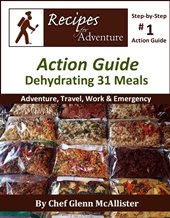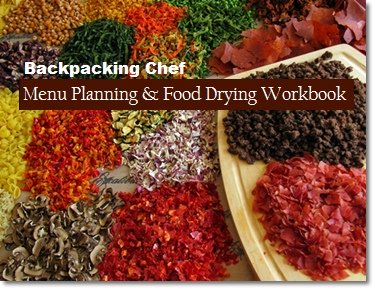How to Dehydrate Chickpeas & Hummus
Are you wondering how to dehydrate chickpeas so that they rehydrate to a firm, but not hard texture? There’s an easy fix to ensure that your dehydrated chickpeas return to a perfect chewiness when used in backpacking meals.
In this article, you’ll find the instructions for dehydrating chickpeas from a can, and for dehydrating dry chickpeas that you soak and cook before drying.
I’ll also cover making and dehydrating hummus. You’ll love the authentic hummus recipe, and how you can rehydrate it instantly with hot or cold water to make hummus wraps, complete backpacking meals, or hummus dip for your veggies at home.
Lastly, I’ll show how to grind dehydrated chickpeas into a powder to add to ground beef or chicken before cooking and drying it. That little secret ensures the meat will rehydrate well in meals.
Dehydrating
Canned Chickpeas
Dehydrating canned chickpeas is fast and easy. However, if you want them to rehydrate well after you dry them, then you will want to cut them in half before placing them on the dehydrator trays.
Do you have to cook canned chickpeas? No, they are already cooked.
Steps:
Drain and rinse chickpeas in a colander.
Cut chickpeas in half on a cutting board. This goes faster than you might guess—about ten minutes per can. Discard any skins that come loose.
Dried chickpeas can be eaten as crunchy snacks. If that’s your plan, place chickpeas in a bowl and stir in seasoning salt to taste and/or any combination of seasonings such as garlic powder, chili powder, paprika, cumin, etc.
Spread chickpeas in a single layer on a dehydrator tray covered with a mesh sheet.
Dehydrate chickpeas at 125°F (52°C) for 5–6 hours. Dried chickpeas with be hard and crunchy.
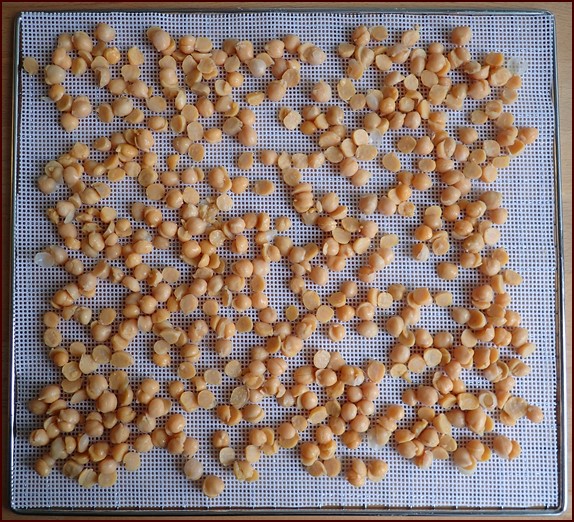
Photo: One can of halved chickpeas on one Cosori dehydrator tray covered with a silicone mesh sheet.
Yield: One 250 gram can of chickpeas (1¾ cups) will yield one cup of dried chickpeas (85 g).

Photo: Dehydrated chickpeas.
Cooking
& Dehydrating Dry Chickpeas
Dry chickpeas are less expensive than canned chickpeas, and you can often find them certified organic. All you have to do is soak them overnight and cook them.
Soak:
Place chickpeas in a bowl and cover with an inch of water. Soak overnight, approximately 12 hours.
Transfer chickpeas to a colander, drain soak water, and rinse.
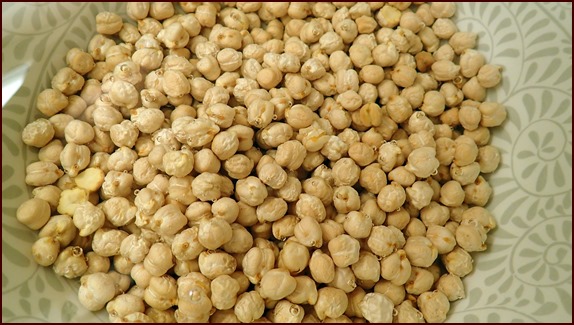
Photo: Chickpeas soaking in water.
Cook:
Cook time: 40 minutes.
These cooking instructions are for 1¼ cups (250 g) of dried chickpeas. This quantity will produce enough cooked chickpeas to fill two Cosori dehydrator trays, or to make one batch of hummus for drying on three trays. However, to save time and to cook enough chickpeas to fill more trays, you can double the quantities and cook 2½ cups (500 g) of dried chickpeas.
After soaking 1¼ cups (250 g) of chickpeas overnight, rinse and place them in a large sauce pot with 1¼ liters of water.
Add ½-tsp. of baking soda (sodium bicarbonate), plus ½-tsp. of salt to the water per 250 grams of chickpeas being cooked. Note that baking soda is not the same thing as baking powder. Baking soda raises the pH level of the water and helps soften the chickpeas. If you don’t have baking soda on hand, it’s not a deal breaker… carry on without it.
Bring water to a boil, then reduce heat to medium and simmer chickpeas for approximately 40 minutes until soft.
Once chickpeas are cooked, most of the skins will have detached. It’s easy to pour them off with the cooking water. Repeat by adding more cold water to the pot to pour off more of the floating skins, or fish them out with a slotted spoon.
Cooked Yield: 1¼ cups (250 g) of dry chickpeas will produce 3 cups (500 g) of cooked chickpeas.
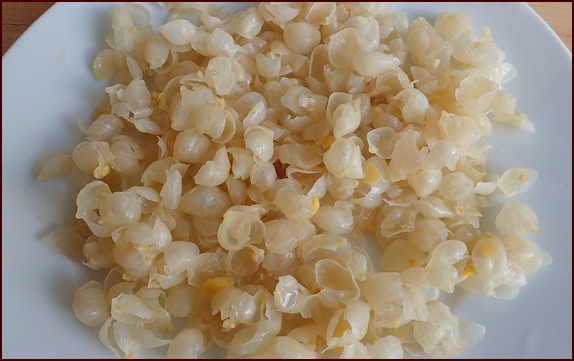
Photo: Discarded chickpea skins.
How to Dehydrate Chickpeas:
Cut cooked chickpeas in half. This will take about 10 minutes, but will result in chickpeas that rehydrate better than whole chickpeas due to the insides of chickpeas absorbing water faster.
Arrange chickpeas in a single layer on mesh dehydrator sheets and dehydrate at 125°F (52°C) for 5–6 hours.
Dried Yield: 3 cups (500 g) of cooked chickpeas will yield 1¾ cups (175 g) of dehydrated chickpeas.
Dehydrated Chickpeas Recipes
Dehydrated chickpeas are an excellent substitution for chicken in vegetarian backpacking meals. They offer a nice chewy texture, similar color, and protein. You can also add some to the vegetable component of any dried meal to bump up the protein.
Eggplant Parmesan with Chickpeas
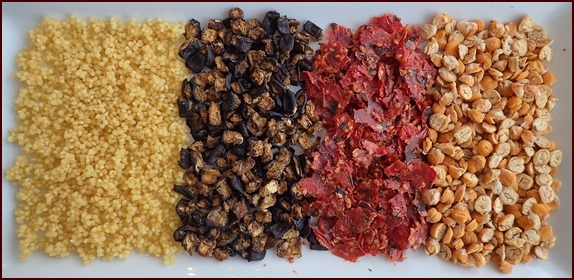
Ingredients for 1 large serving: ⅓ cup dried pearl couscous (40 g), ⅓ cup dried eggplant (25 g), ⅓ cup dried stewed tomatoes or tomato leather (16 g), ⅓ cup dried chickpeas (30 g), 1 Tbsp. olive oil, 3 Tbsp. parmesan cheese, and 1½ cups water to rehydrate.
See Dehydrating Eggplant for more details about preparing this backpacking meal.
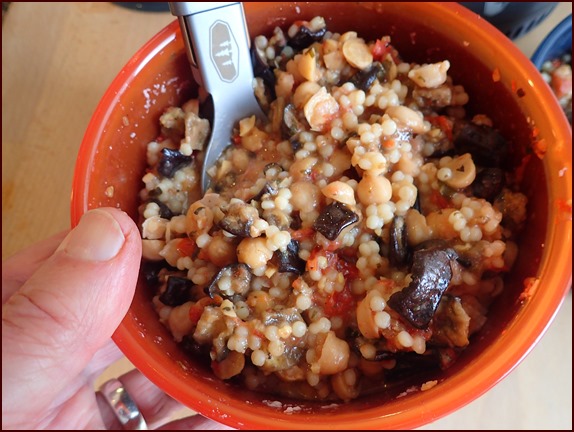
Photo: Rehydrated eggplant parmesan with chickpeas.
Substituting Chickpeas for
Chicken
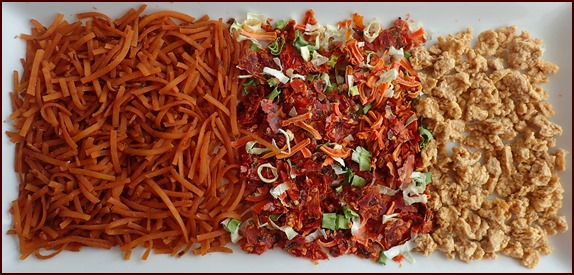
Photo: Thai Peanut Noodles with Veggies & Chicken or Chickpeas.
In dehydrated meals like the one shown above, you can make the meal vegetarian by substituting chickpeas 1:1 for the chicken.
Recipe prepared with chickpeas, 2 servings: ¾-cup dried Thai peanut noodles (75 g), ½-cup dried mixed veggies (25 g), and ¼-cup dried chickpeas (25 g). Rehydrate with 2¼ cups boiled water.
Explore more: How to Make & Dehydrate Thai Peanut Noodles.
Making &
Dehydrating Hummus
The two tricks for making super-smooth hummus are to add baking soda to the chickpea cooking water, as previously described, and to discard as many of the skins as possible. Credit goes to Maša Ofei at HeartfulTable.com for those tips, and you can read more there: Making Hummus from Scratch.
How to Make Hummus
For each batch of hummus, cook 1¼-cups (250 g) of dry chickpeas with baking soda and salt, as previously described, to end up with three cups of cooked chickpeas. Alternatively, use three cups of canned chickpeas.
I recommend going with this quantity per batch so as not to overwork your blender.
Hummus Ingredients:
- 3 cups cooked or canned chickpeas
- ⅓ cup hulled tahini (85 g) Tahini is a paste made from sesame seeds
- ⅓ cup fresh lemon juice (80 ml)
- 2 cloves garlic, minced
- 1 tsp. salt
- ¼ tsp. cumin powder
- ¾ cup water
Steps:
Discard as many chickpea skins as possible. If using canned chickpeas, you may want to cook them for a minute to loosen the skins.
Add the chickpeas plus all the other ingredients to a blender. If you are making the hummus without dehydrating it, you may get by with ½-cup of water for a thicker hummus, instead of ¾-cup. Either way, you can start out with less water and add more if needed to help the blender along.
Blend in short pulses until hummus is well-mixed and smooth. This goes pretty fast, but you may need to redistribute the contents of the blender in between pulses.
Yield: Approximately 3 cups blended hummus, about 500 grams.
How to Dehydrate Hummus
Spread hummus thinly on nonstick dehydrator trays. If using a Cosori dehydrator, spread one cup of hummus on each of three trays.
Dehydrate hummus at 125°F (52°C) for 5–6 hours.
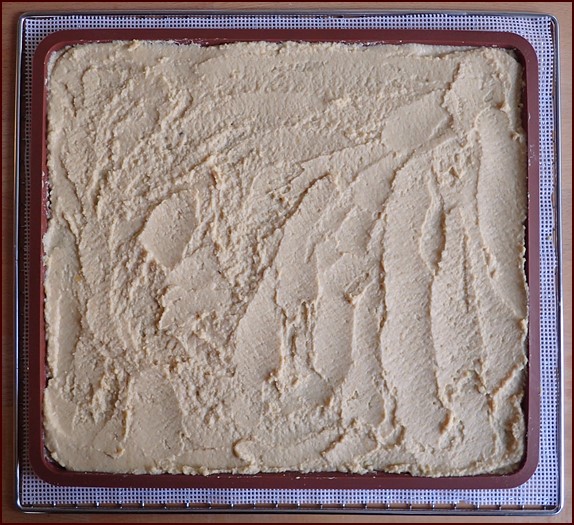
Photo: One cup of hummus spread on a silicone dehydrator tray for Cosori dehydrator.
Hummus will dry like mud with lots of cracks, as shown in the photo below.
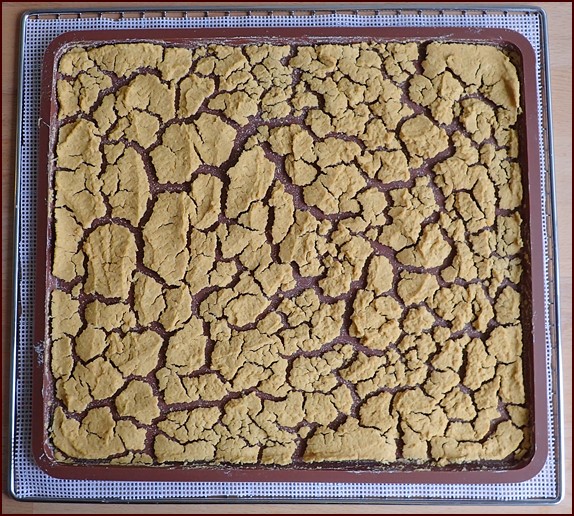
Photo: Dehydrated hummus.
Dried hummus can be crumbled into bits by hand, but for best rehydration later, run it through a blender. Make sure the inside of the blender is completely dry.
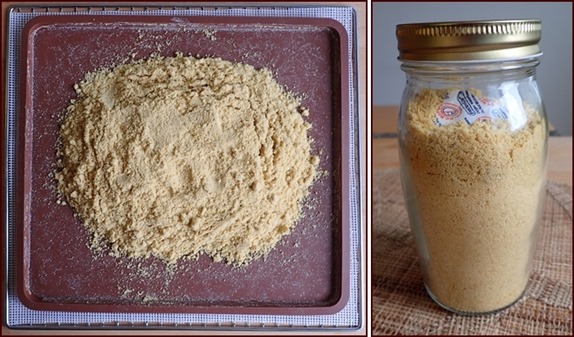
Photo: Dehydrated hummus ground into powder.
Yield: This recipe yields 2¼-cups dried hummus powder (240 g).
Storing Dried Hummus
Store dried hummus at home in an airtight container with an oxygen absorber. It will keep for several months. When packing for the trail, a Ziploc bag is sufficient for a week or two, but consider vacuum sealing for longer trips. Tahini has oil in it, which can go rancid with long term exposure to oxygen, so it will hold up better if vacuum-sealed.
For recommended food storage accessories like vacuum sealers, jar sealers, Mylar bags, and oxygen absorbers, see:
Backpacking Chef Food & Gear Guide.
Rehydrating
Dried Hummus
Dried hummus powder rehydrates instantly in hot or cold water.
The ratio of water to dried hummus powder is 1:1. For example, rehydrate ½-cup of hummus powder (50 g) with ½-cup of water. You may wish to start with a little less water and add more as needed to achieve your desired texture. It continues to thicken a bit if you let it sit a few minutes.
Because dehydrated hummus rehydrates quickly, it makes a great spread for no-cook backpacking lunches like hummus tortilla wraps.
Dehydrated
Hummus Recipes
Hummus & Veggie
Tortilla Wraps
Makes 3–4 small tortilla wraps.
Ingredients:
- ½ cup powdered hummus (50 g)
- ½ cup dried mixed vegetables (25 g)
- 2 Tbsp. pine nuts (optional)
- 3–4 tortillas
- 1 cup cold water to rehydrate
- 2–3 packets of olive oil (optional)
Pack dried vegetables, hummus powder, and tortillas in separate bags.
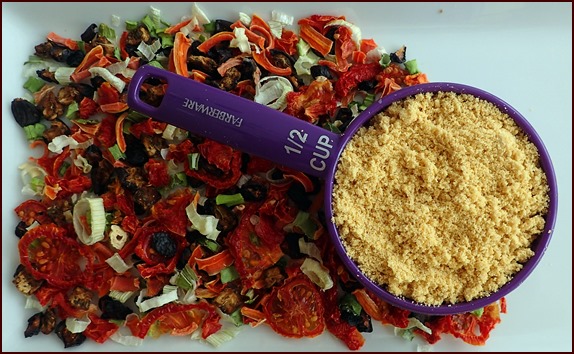
Photo: Dehydrated hummus powder & dried veggies.
On the Trail:
Dried vegetables take longer to rehydrate in cold water, so presoak the vegetables in ½-cup of cold water at least 30 minutes before preparing the meal. This can be done in a Ziploc bag or sealed container a mile or two before you stop for lunch.
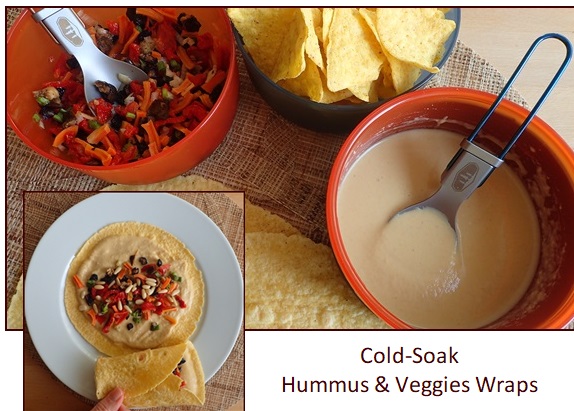
Photo: Making tortilla wraps with hummus and vegetables.
At lunchtime, you could prepare the wraps in one of two ways:
Method One: Add the hummus powder to the container with the rehydrated vegetables including the soak water. Add more water as needed to make it as thick as desired. Spread mixture on tortilla wraps and fold up. I like this method best because it requires only one container.
Method Two: Rehydrate the hummus separately (½-cup hummus powder with ½-cup water). When fully rehydrated, spread on tortillas and top with vegetables.
Stir in olive oil before serving if using.
Hummus Bowl with Beef, Rice
& Veggies
This is a delicious meal rehydrated with hot water. Eat it right out of the pot, in bowls, or folded up in tortillas.
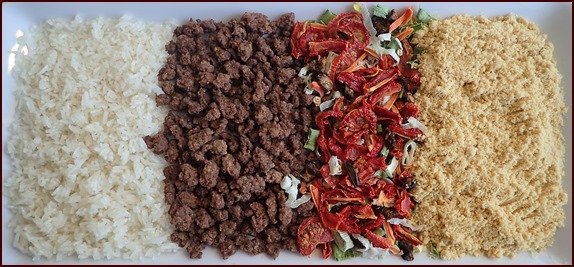
Photo: Dried hummus bowl ingredients.
Servings: 2 bowls, or 4 tortillas
Ingredients:
- ½ cup dried rice (50 g)
- ½ cup dried ground beef (50 g)
- ½ cup dried mixed vegetables (25 g)
- ½ cup dried hummus powder (50 g)
- 2½ cups boiled water to rehydrate
Pack hummus powder in a separate bag.
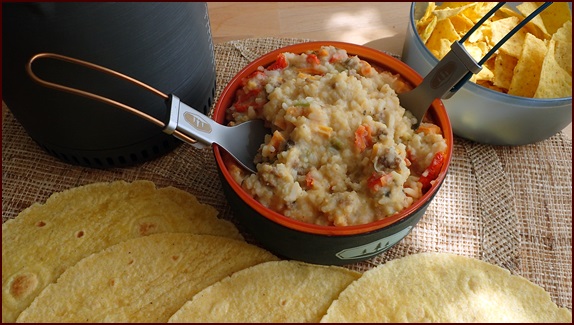
Photo: Rehydrated Hummus with Beef, Rice & Veggies.
On the Trail:
Place all ingredients except hummus powder in pot with water. Soak five minutes, then light stove and bring to a boil. Remove pot from stove, stir in hummus powder, and let pot sit in an insulating pot cozy for about 15 minutes. Since hummus powder absorbs water fast, I recommend adding the hummus powder last. That way you won’t scorch the bottom of the pot.
Eat right out of the pot, divide into bowls, or wrap up in tortillas one at a time.
Adding Dehydrated
Chickpeas to Ground Meat
When preparing ground beef or chicken for dehydration, I have discovered that it rehydrates much better if a ground up starch is added to the meat before cooking and drying it.
Ground chickpeas work well as the added starch, as do ground breadcrumbs and ground oats.
For one pound of ground beef, chicken, or turkey, work ½-cup of ground chickpeas into the meat before cooking it.
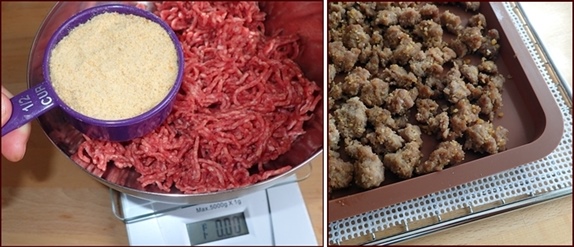
Photo: Adding ground chickpeas to ground beef before cooking and dehydrating.
Grinding Dehydrated
Chickpeas into Powder
Dehydrate chickpeas as previously described.
A 250-gram can of chickpeas contains about 1¾-cups of chickpeas. After drying, you’ll have 1-cup of dried chickpeas.
Grind chickpeas to powder consistency in a blender or grinder using short pulses.
Yield: 1 cup of dehydrated chickpeas (85 g) will produce ½-cup of ground chickpeas plus a few tablespoons extra.
Use ½-cup of ground chickpeas per pound of ground meat.
For further cooking and drying instructions, see:
Dehydrating Ground Chicken & Turkey
Dehydrator Accessories
Shop Amazon for the Cosori dehydrator and accessories used for dehydrating chickpeas and hummus on this page. The silicone trays and silicone mesh sheets are flexible, truly nonstick, and are very easy to clean. Mesh sheets can be cut to size with scissors.

Left: Hlimior Silicone Dehydrator Trays with Raised Edges, 12” x 10.6”, 6-Pack
Middle: Cosori Dehydrator, Stainless Steel, 6-Trays
Right: Dostk Silicone Mesh Dehydrator Sheets, 14” x 14”, 12-Pack
Disclosure: As an Amazon Associate, Backpacking Chef earns from qualifying purchases.
Explore More…
Recipes for Adventure Books

Share this page with friends on social media.
Free E-book & Newsletter
Free with Trail Bytes subscription.
Dehydrating Food from A–Z





